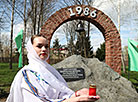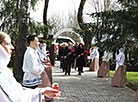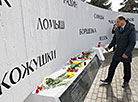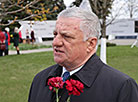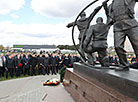Belarus marks 35 years of Chernobyl accident
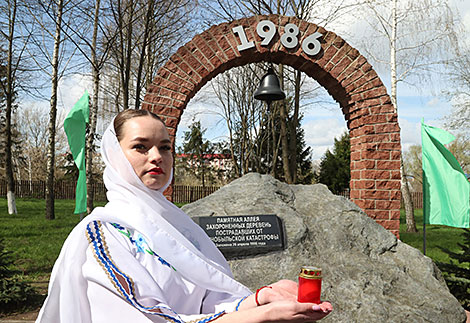
Belarus will never forget this day... An accident at the Chernobyl nuclear power plant, located just 16km from the Belarusian border, occurred on 26 April 1986, at 01:24. It was one of the largest man-made disasters in the history of mankind. In the 1980s it was the most powerful nuclear power plant in the Soviet Union. The explosion at the fourth unit had catastrophic consequences not only for Ukraine but also for many European countries. In terms of the scale of radioactive contamination and damage to nature, agriculture and regional economies the accident became a national environmental disaster for Belarus.
As a result of the accident, a record range of radionuclides was released into the atmosphere, including iodine-131 (half-life of 8 days), cesium-134 (2 years), strontium-90 (28-29 years). Cesium-137 has the longest half-life (30 years), and 35%(!) of its fallout landed in the south of Belarus. There was the most affected 30km zone around the plant. Residual amount also distributed as radioactive patches due to the weather conditions. The north-west patch spanned the southern and southwestern parts of Gomel Oblast, and the central parts of Brest Oblast, Grodno Oblast and Minsk Oblast. The third patch took shape in the north of Gomel Oblast and the central part of Mogilev Oblast. Out of 3,678 settlements (2.2 million people), 479 were destroyed and 137,700 people were resettled, 75% of whom were residents of Gomel Oblast.
Today, 35 years on, Belarus remembers that terrible day, which divided the country's history and the lives of hundreds of thousands of residents into ‘before’ and ‘after’. The Polesie State Radiation and Ecology Reserve, the only one of its kind in the world, has been set up in the contaminated zone. Here scientists study radionuclides and their migration in ecosystems. After the Fukushima accident in 2011, Japanese specialists came here to exchange experience.
The main task regarding the affected areas (which includes 19 districts of Gomel Oblast, 13 districts of Mogilev Oblast, 4 districts of Brest Oblast, 10 districts of Minsk Oblast, 3 districts of Grodno Oblast) is their recovery. Belarus implements state programs to mitigate the impact of the Chernobyl nuclear accident. Some $19.2 billion was allocated under these programs from 1990 to 2020. In 2016-2020, about 60% of the funds was earmarked for social welfare, healthcare and rehabilitation of the population. On 22 March 2021, the government approved a new state program for 2021-2025 to improve social welfare of the population affected by the Chernobyl disaster, to ensure radiation safety requirements, accelerate social and economic development and revival of areas contaminated with radionuclides.
Commemorative events were held across Belarus to mark the 35th anniversary of the accident. They kicked off with a rally to honor the memory of the villages that were abandoned after the Chernobyl disaster that was held in the Alley of Memory in Slavgorod on 23 April. Another rally, which took place in Ignatenko Street in Minsk on 26 May, celebrated the first responders at the site of the Chernobyl Nuclear Power Plant: staff of the plant and firefighters Viktor Kibenok, Vladimir Pravik, Nikolai Titenok, Vladimir Tishura, Nikolai Vashchuk, Vasily Ignatenko, and others. On 26 April, Aleksandr Lukashenko visited the city of Bragin and laid flowers at the monument to firefighter Vasily Ignatenko, a native of the village of Sperizhye in Bragin District. On 24 December 1986, he was posthumously awarded the Order of the Red Banner.
Belarusian officials laid flowers at the commemorative signs "Chernobyl Victims" and "Hiroshima Peace Stone" in the Park of People's Friendship in Minsk. Khoiniki hosted a commemorative meeting to lay flowers and wreaths at the Sorrow monument and plant an alley of 35 willow trees – a tree per every year since the Chernobyl disaster. More than 300 people, including liquidators (there are more than 70,000 of them in Belarus), gathered in Mogilev to pay tribute to those who were killed or affected by the Chernobyl catastrophe and lay flowers at the monument “Chernobyl Victims”.
Belarusian culture institutions also marked the 35th anniversary of the Chernobyl disaster. For example, an art exhibition went on view in Gomel on 16 April. The exhibition demonstrated 70 works by artists from various regions of Belarus illustrating the chronology of the disaster, including paintings, drawings, sculptures, and works of applied arts. A documentary exhibition Chernobyl – 35… was opened in the State Museum of History of Belarusian Literature on 26 April. As part of the Abandoned Land project, which was launched in the National Historical Museum on 26 April, visitors can see photos of flora and fauna of the Polesie State Radiation and Ecology Reserve where rare and endangered species dwell. On the eve of the anniversary – 25 April – the Belarusian State Philharmonic performed Chernobyl Liturgy by Metropolitan Jonathan (Yeletskikh). It is the first spiritual choir composition of its kind, an Orthodox requiem in memory of the fallen heroes, who cleaned up the aftermath of the nuclear power plant accident in 1986.







